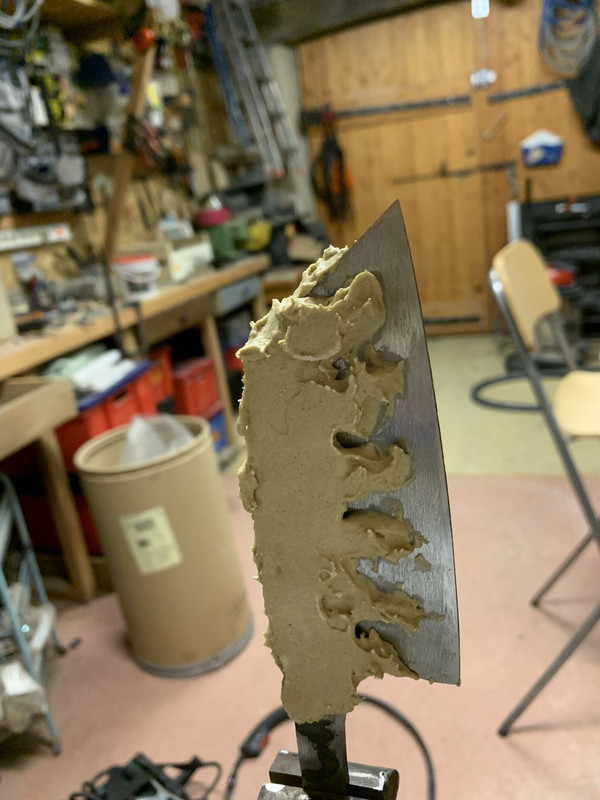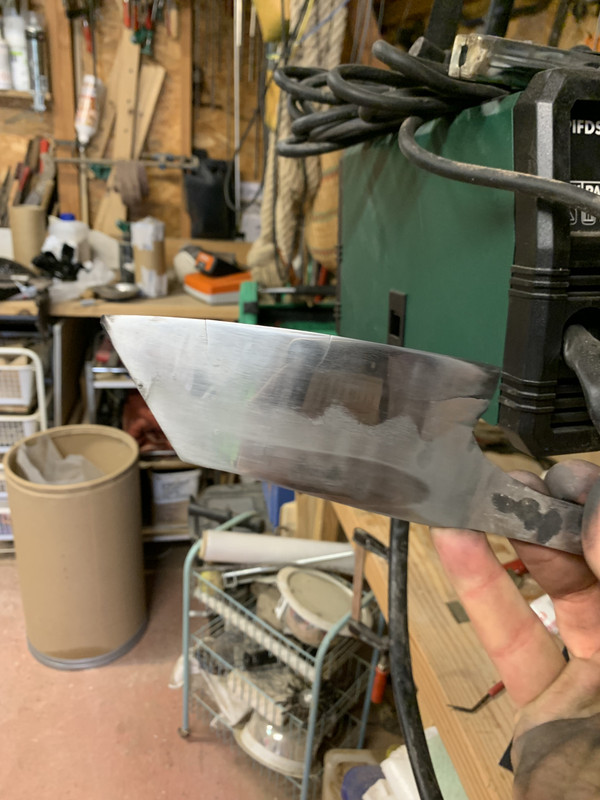Rest of info:
MORE INFO:
A hamon forms in shallow hardening steels. Any alloy ingredient will make the steel deeper hardening, and thus wash out or block the formation of the hamon. 5160, 52100, O-1, D-2, and other higher allow steels are not suitable for hamon development.
A short course in hamon formation may be in order:
A simple steel has carbon and iron. Anything else is an alloy ingredient. W2 has about 1% carbon and 98.25% iron. There is also a .25% amount of manganese, silicon, and vanadium (typical assay). These alloy amounts are small enough to have little effect on the hardenability. Be aware that all W2 and other steels don't always have the perfect alloy specs. Get a cert with any steel you buy.
When the steel is heated to about 1450F, the carbon goes into solution, and forms a structure called austenite. Upon cooling the steel can do one of several things. If cooled slower than one second to get below 900F, it will form pearlite, a soft structure of steel. If cooled fast enough to miss this "pearlite Nose", the steel will remain as supercooled austenite until it reaches about 400F, where it will start converting into martensite. Martensite is the hard steel we want for cutting tools. Besides the hardness, martensite and pearlite have different crystaline and visual properties. They also react differently to etching.
Now, when the clay coated blade is heated to the austenitization point, and then quenched in water/brine/fast oil, the edge immediately cools to below the pearlite nose, and at 400F converts into martensite. The clay insulated spine retains its heat, and cools slower, thus converting into pearlite. The junction of the two structures is the hamon. This area is a mixture of fine pearlite, coarse pearlite, and martensite crystals. In my early days studying metallurgy this structure was called Troosite, but now we just call it a mixed structure.
Highlighting the effects of this transition area by proper polishing and etching to bring out the optical characteristics of these structures is the skill required in shiage-togi.
The final hamon you get is somewhat of a mystery, but the methods are not.
I have posted several hamon tutorials in the past, but here is a simple guide for a suguha hamon:
Start with a blade that has been through foundation shaping (shitaji togi to form the basic sugata), and is ready for yaki-ire. Normalize the blade before HT. The condition of the steel before HT will greatly affect the final results. Coarse pearlite with fine grain is the desired structure to start with.
Note - While not everyone agrees, it seems that machine work (grinders and milling machines) can create stresses that show up in the final hamon results. Many smiths make the blade by whatever method they wish (forging is the usual way), and then anneal or normalize the blade. After that they do all the shaping work with stones and files. If you are having issues with blades cracking, try shaping by hand with files and stones.
Applying the clay:
Make a simple stand/clamp that will hold the blade by the tang and allow you to work with both hands. The ability to rotate the blade and work both sides is important. A trip to Harbor Freight will yield some inexpensive clamps that rotate. Mount the clamp firmly so you can sit or stand by the blade and do the clay work.
If you are married, or have a good partner, Don't do clay coating in the kitchen.
I recommend that you use satanite for the clay. You will read about AP-green, Atlas/Rutland furnace cement, etc., but satanite is cheap, reliable, and works perfect.
Make a thin mix, about like heavy cream, and apply a wash to the whole blade. Dry with a hair dryer or heat gun.
Thicken the mix with more satanite until it is about like sour cream. Apply this to the spine area, bringing it down toward the edge. Stop about 1/4" before the edge. Do the same to the other side, trying to make both match. Use a popsicle stick to smooth the layers to about 1/16" to 1/8" thick. Take your fingers and wipe the edge in a straight line, removing the excess along the edge. This will leave the ha exposed for about 1/4". The pattern you leave in the exposed steel will shape the hamon. Dry the blade with the hair dryer.
Note: If you as doing a blade that you wish to control sori somewhat, you can wipe the satanite off the mune (spine).
Do yaki-ire as desired, keeping the austenitizing temperature on the lower side. For example, 1070 says "1450°-1525°F" Try 1450°F.
After quench, clean the blade and examine the edges for ha-giri - tiny cracks running from the edge inward. If there, discard the blade and start again.
After a snap temper, a light sanding, followed by a quick dip in FC may show the potential hamon line. This is not the final result, just a confirmation of different structures in the blade.
If inspection goes well, do the final shitaji-togi (foundation polishing) - the hamon may not be visible at all at this point. Get all the shaping right at this stage. Removal of excess metal will not be possible in the next stage.
Please Note:
The blade will be getting sharp as you do togi. Use caution as you go, and extreme caution in the final stages of shiage-togi. Misuse of things like hazuya stones and nugui can lead to having no fingerprints ... or fingertips if not done right. Doing a hybrid polish instead of traditional togi on your first several blades is a good idea.
Continue onto shiage-togi (finish polishing), where the hamon will start to re-appear.
Use of a variety of methods and etchants can bring the subtleties of the hamon out in the final steps. Ther are many articles and threads on doing this
General notes:
The hamon will not be exactly where the clay stops. Experience, and your own equipment will teach you how to place the hamon.
If the hamon does not appear to have developed, re-do the clay work and HT.
Note that fast oil is safer, but any hamon will be faint or may not exist at all. Brine will develop the best activity (hataraki). Brine will crack some blades until you get it mastered ... somewhat. Water is wonderful for a hamon, but will break a lot of blades.
More complex hamon, greater hataraki, ashi, and other features can be developed by changing the shape of the edge of the thicker clay line. Make the line wavy and you can get notare; poke it with a stick into small ridges and get Choji or many other patterns; make small lines to the edge with a slightly thinned slurry and create ashi.
Another thing that affects the hamon is the niku (meat) of the blade toward the edge. The amount of thickness and grind shape toward the edge affects the quench and how fast the steel cools. I like a slight apple-seed grind.
Info for polishing the hamon:
I have several articles on hybrid polishing but a short list of the agents that will help develop a hamon are:
Diluted HCl ( 100:1), FC, lemon juice
chromium oxide
red iron oxide
black iron oxide (magnetite)
tin oxide, FC
fine SC grit
3M polishing papers ( 400-8000)
Choji or other pure oil
Flitz polish
1.25" round gun cleaning patches.....lots of them!
Other supplies:
White enamel paint (Testors) and finer sable brushes
popsicle sticks
Tough painters tape to mask areas off (Frog tape)
There are several good books on the subject, and some good DVD's.
A few are:
Walter Sorrells - Hamon (and his entire set on Japanese blades)
Setsuo Takaiwa - The Art of Japanese Sword Polishing (I highly recommend this book)
Clive Sinclaire - Samurai Swords


